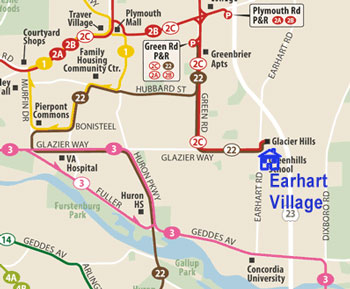Millage at the Village: Ward 2 Transit Talk
Voters in Ann Arbor, Ypsilanti and Ypsilanti Township will decide on May 6, 2014 whether they want to pay an additional 0.7 mill tax for five years – to fund increased public transportation service.
Exactly one week before the vote, Ward 2 Ann Arbor city councilmembers Jane Lumm and Sally Petersen hosted a resident meeting on the topic.

This AAATA route map shows the current configuration of fixed-route buses. Label and icon for Earhart Village added by The Chronicle.
Invited were all residents of Ward 2, city residents at large, as well as representatives of the Ann Arbor Area Transportation Authority. The AAATA board voted in February to place the millage on the May 6 ballot.
About 50 people attended. Among others, the meeting drew Ward 2 city council candidate Nancy Kaplan, former Ward 1 council candidate Jeff Hayner, former mayor Ingrid Sheldon, Ward 3 council candidate Julie Grand, and state rep Jeff Irwin (D-53).
This is a report of that meeting.
Lumm and Petersen had previously co-hosted a half dozen similar meetings for their constituents on a variety of topics. The April 29 event had a potentially broader impact: At a candidate forum held on April 16, 2014, mayoral hopeful Petersen had stated that she was planning to wait until after the April 29 ward meeting to decide on a possible endorsement of the millage.
At that time, Petersen was still a little bit on the fence – but leaning toward supporting it. By then, the three other candidates in the Democratic mayoral primary – Sabra Briere, Christopher Taylor and Stephen Kunselman – had already indicated support for the additional tax.
The April 29 evening meeting was held at Earhart Village – a 174-unit condominium community just off the north-south Earhart Road, between Plymouth and Geddes. The Route #2 bus line runs from downtown to the northeast up Plymouth – with a relatively infrequent variant, Route #2C, that offers service down from Plymouth to the Earhart Village area. Accessing Route #3 to the south, on Geddes, would mean about a 1-mile walk up Earhart for an Earhart Village resident.
Frequency of service to the Earhart Village area was among the complaints of some attendees. Many in the room were negatively inclined toward the millage, as one woman announced she’d already voted no, using an absentee ballot. But there were some voices in the room that backed the proposal. Responding to criticism that the AAATA was not a “lean-and-mean” organization, a teacher in the audience made a comparison to cuts by the school district: “Lean-and-mean is not serving our students.”
AAATA staff Chris White, Michael Benham, and Mary Stasiak gave a presentation to the group before fielding questions. Lumm and Petersen structured the interaction by reading questions that attendees had written on index cards, but people were also free to ask direct questions. Some questions were pointedly critical in tone: “Does the millage money cover the additional wear and tear on the roads due to the additional buses?” And some were softballs: “Do Ward 2 constituents understand the benefit of bus expansion for low-income people and people with disabilities?”
At the conclusion of the meeting, Petersen quipped: “We had loaded questions, we had loaded answers. Hopefully one way or another we’ll have loaded buses sometime soon!” And Petersen announced her support for the millage two days later at a May 1 morning meeting of the Main Street Area Association.
However loaded the questions might have been, they elicited some useful information about how public transportation works. This report is organized along three broad themes reflected in the questions and comments from residents: overall efficiency of the AAATA as an organization; the nature of transportation funding; and some basics of public transportation service. The report is supplemented with charts generated from a national transit database. [Full Story]



